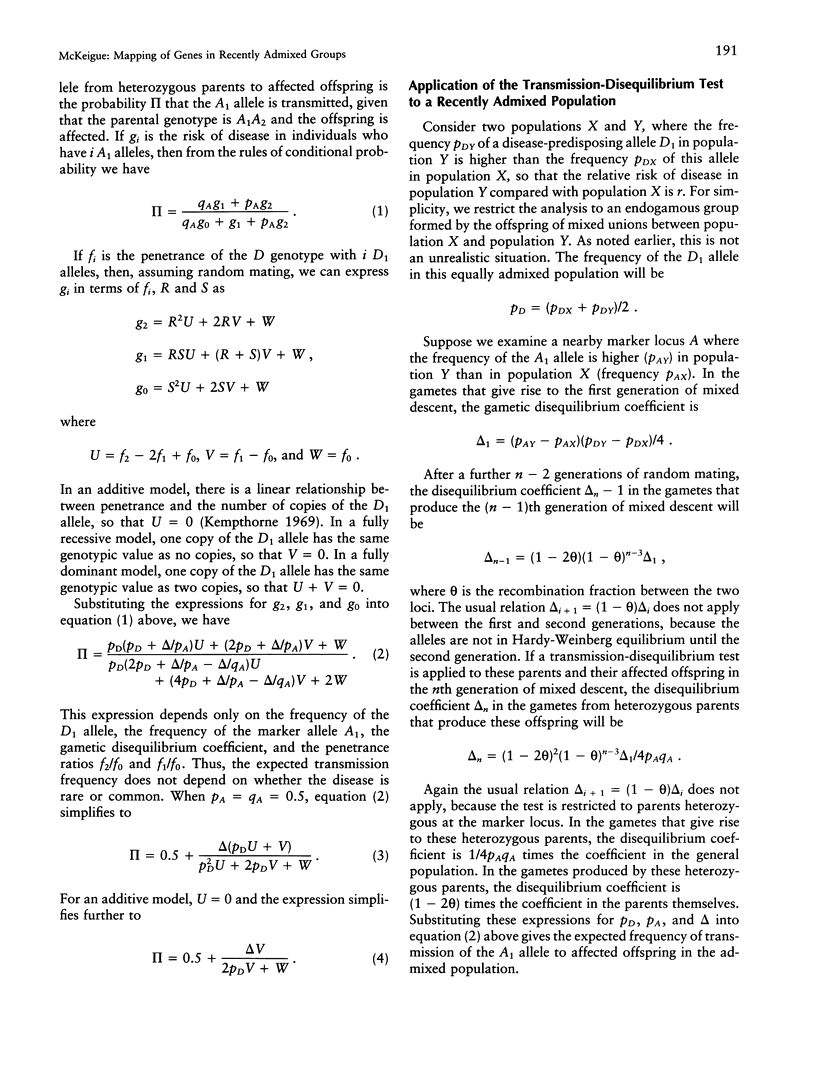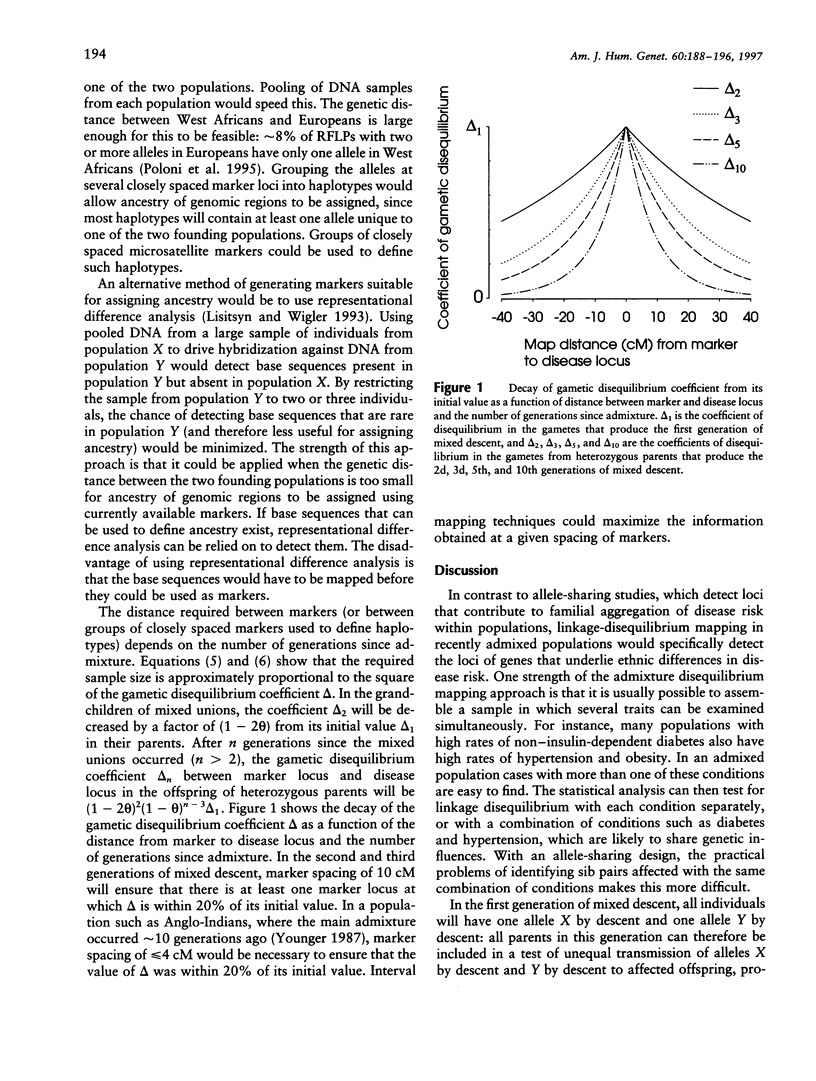Abstract
Where recent admixture has occurred between two populations that have different disease rates for genetic reasons, family-based association studies can be used to map the genes underlying these differences, if the ancestry of the alleles at each locus examined can be assigned to one of the two founding populations. This article explores the statistical power and design requirements of this approach. Markers suitable for assigning the ancestry of genomic regions could be defined by grouping alleles at closely spaced microsatellite loci into haplotypes, or generated by representational difference analysis. For a given relative risk between populations, the sample size required to detect a disease locus that accounts for this relative risk by linkage-disequilibrium mapping in an admixed population is not critically dependent on assumptions about genotype penetrances or allele frequencies. Using the transmission-disequilibrium test to search the genome for a locus that accounts for a relative risk of between 2 and 3 in a high-risk population, compared with a low-risk population, generally requires between 150 and 800 case-parent pairs of mixed descent. The optimal strategy is to conduct an initial study using markers spaced at < or = 10 cM with cases from the second and third generations of mixed descent, and then to map the disease loci more accurately in a subsequent study of a population with a longer history of admixture. This approach has greater statistical power than allele-sharing designs and has obvious applications to the genetics of hypertension, non-insulin-dependent diabetes, and obesity.
Full text
PDF








Selected References
These references are in PubMed. This may not be the complete list of references from this article.
- Chakraborty R., Ferrell R. E., Stern M. P., Haffner S. M., Hazuda H. P., Rosenthal M. Relationship of prevalence of non-insulin-dependent diabetes mellitus to Amerindian admixture in the Mexican Americans of San Antonio, Texas. Genet Epidemiol. 1986;3(6):435–454. doi: 10.1002/gepi.1370030608. [DOI] [PubMed] [Google Scholar]
- Chakraborty R., Weiss K. M. Admixture as a tool for finding linked genes and detecting that difference from allelic association between loci. Proc Natl Acad Sci U S A. 1988 Dec;85(23):9119–9123. doi: 10.1073/pnas.85.23.9119. [DOI] [PMC free article] [PubMed] [Google Scholar]
- Dunn J. E. Cancer epidemiology in populations of the United States--with emphasis on Hawaii and California--and Japan. Cancer Res. 1975 Nov;35(11 Pt 2):3240–3245. [PubMed] [Google Scholar]
- Ewens W. J., Spielman R. S. The transmission/disequilibrium test: history, subdivision, and admixture. Am J Hum Genet. 1995 Aug;57(2):455–464. [PMC free article] [PubMed] [Google Scholar]
- Hodge A. M., Zimmet P. Z. The epidemiology of obesity. Baillieres Clin Endocrinol Metab. 1994 Jul;8(3):577–599. doi: 10.1016/s0950-351x(05)80287-3. [DOI] [PubMed] [Google Scholar]
- Lander E., Kruglyak L. Genetic dissection of complex traits: guidelines for interpreting and reporting linkage results. Nat Genet. 1995 Nov;11(3):241–247. doi: 10.1038/ng1195-241. [DOI] [PubMed] [Google Scholar]
- Lisitsyn N., Lisitsyn N., Wigler M. Cloning the differences between two complex genomes. Science. 1993 Feb 12;259(5097):946–951. doi: 10.1126/science.8438152. [DOI] [PubMed] [Google Scholar]
- Manatunga A. K., Jones J. J., Pratt J. H. Longitudinal assessment of blood pressures in black and white children. Hypertension. 1993 Jul;22(1):84–89. doi: 10.1161/01.hyp.22.1.84. [DOI] [PubMed] [Google Scholar]
- McKeigue P. M., Miller G. J., Marmot M. G. Coronary heart disease in south Asians overseas: a review. J Clin Epidemiol. 1989;42(7):597–609. doi: 10.1016/0895-4356(89)90002-4. [DOI] [PubMed] [Google Scholar]
- McKeigue P. M., Shah B., Marmot M. G. Relation of central obesity and insulin resistance with high diabetes prevalence and cardiovascular risk in South Asians. Lancet. 1991 Feb 16;337(8738):382–386. doi: 10.1016/0140-6736(91)91164-p. [DOI] [PubMed] [Google Scholar]
- Miller G. J., Beckles G. L., Maude G. H., Carson D. C., Alexis S. D., Price S. G., Byam N. T. Ethnicity and other characteristics predictive of coronary heart disease in a developing community: principal results of the St James Survey, Trinidad. Int J Epidemiol. 1989 Dec;18(4):808–817. doi: 10.1093/ije/18.4.808. [DOI] [PubMed] [Google Scholar]
- NEEL J. V. Diabetes mellitus: a "thrifty" genotype rendered detrimental by "progress"? Am J Hum Genet. 1962 Dec;14:353–362. [PMC free article] [PubMed] [Google Scholar]
- Poloni E. S., Excoffier L., Mountain J. L., Langaney A., Cavalli-Sforza L. L. Nuclear DNA polymorphism in a Mandenka population from Senegal: comparison with eight other human populations. Ann Hum Genet. 1995 Jan;59(Pt 1):43–61. doi: 10.1111/j.1469-1809.1995.tb01605.x. [DOI] [PubMed] [Google Scholar]
- Pérusse L., Rice T., Bouchard C., Vogler G. P., Rao D. C. Cardiovascular risk factors in a French-Canadian population: resolution of genetic and familial environmental effects on blood pressure by using extensive information on environmental correlates. Am J Hum Genet. 1989 Aug;45(2):240–251. [PMC free article] [PubMed] [Google Scholar]
- Reid D. D. The future of migrant studies. Isr J Med Sci. 1971 Dec;7(12):1592–1596. [PubMed] [Google Scholar]
- Risch N., Zhang H. Extreme discordant sib pairs for mapping quantitative trait loci in humans. Science. 1995 Jun 16;268(5217):1584–1589. doi: 10.1126/science.7777857. [DOI] [PubMed] [Google Scholar]
- Stephens J. C., Briscoe D., O'Brien S. J. Mapping by admixture linkage disequilibrium in human populations: limits and guidelines. Am J Hum Genet. 1994 Oct;55(4):809–824. [PMC free article] [PubMed] [Google Scholar]
- Thomson G. Mapping disease genes: family-based association studies. Am J Hum Genet. 1995 Aug;57(2):487–498. [PMC free article] [PubMed] [Google Scholar]
- Zimmet P. Z. Kelly West Lecture 1991. Challenges in diabetes epidemiology--from West to the rest. Diabetes Care. 1992 Feb;15(2):232–252. doi: 10.2337/diacare.15.2.232. [DOI] [PubMed] [Google Scholar]


